When you think of Portugal, the first image that most likely comes to mind is its sunny beaches, maritime exploration history, Fado music, and of course the capital Lisbon. In a small town called Guimarães, a new chapter begins when a great character emerges from a series of events and people that make up the country of Portugal. From ancient Celtic and later Germanic tribes to a temporary Moorish rule, we will uncover the diverse past of this mystique of a land that many recognize and love in our modern times by learning from its culture, customs and perseverance that will be discussed in this article.
Background History
The city of Guimarães is located in the northwestern corner of the Iberian Peninsula, and serves as a symbol of the character and foundation of the Portuguese people. Also known as a cradle town. With its well-preserved architecture and castle, it is one of many renowned cultural icons in today's Europe. As seen in the image below, Castelo do Guimarães (Castle of Guimarães) shines perfectly displayed in its impressive present state with hints of its glorious past that are still present in the general appearance.

Castle Guimarães, a symbol of Portugal's humble beginnings and rich history, was home to the first king, Afonso Henriques.
Celtic culture
Originally, the areas that were originally inhabited were Celtic tribes. The Celts who lived at this place in Iberia were also related to other tribes in neighboring countries such as Gaul (Modern Day France) and its other cousins throughout the Atlantic. The people of the country were well versed in their occupations when it came to agriculture, hunting and even making great warrior clans based on kinship.
Children in this civilization were highly valued because they served as a promise of hope to continue the customs, ways, ideas, and general future of the tribes. They grew up learning special dances and practicing martial arts to get their own sword which symbolized their old age. Those who did not serve the sword would usually spend time on rustic tasks such as raising sheep and cattle. In time, this class of people quickly became notorious for the Romans as they began to invade the country for their strong resistance and impressive war skills. On this basis, the Celts in northern Portugal were responsible for the long process of being completely conquered by the Romans.
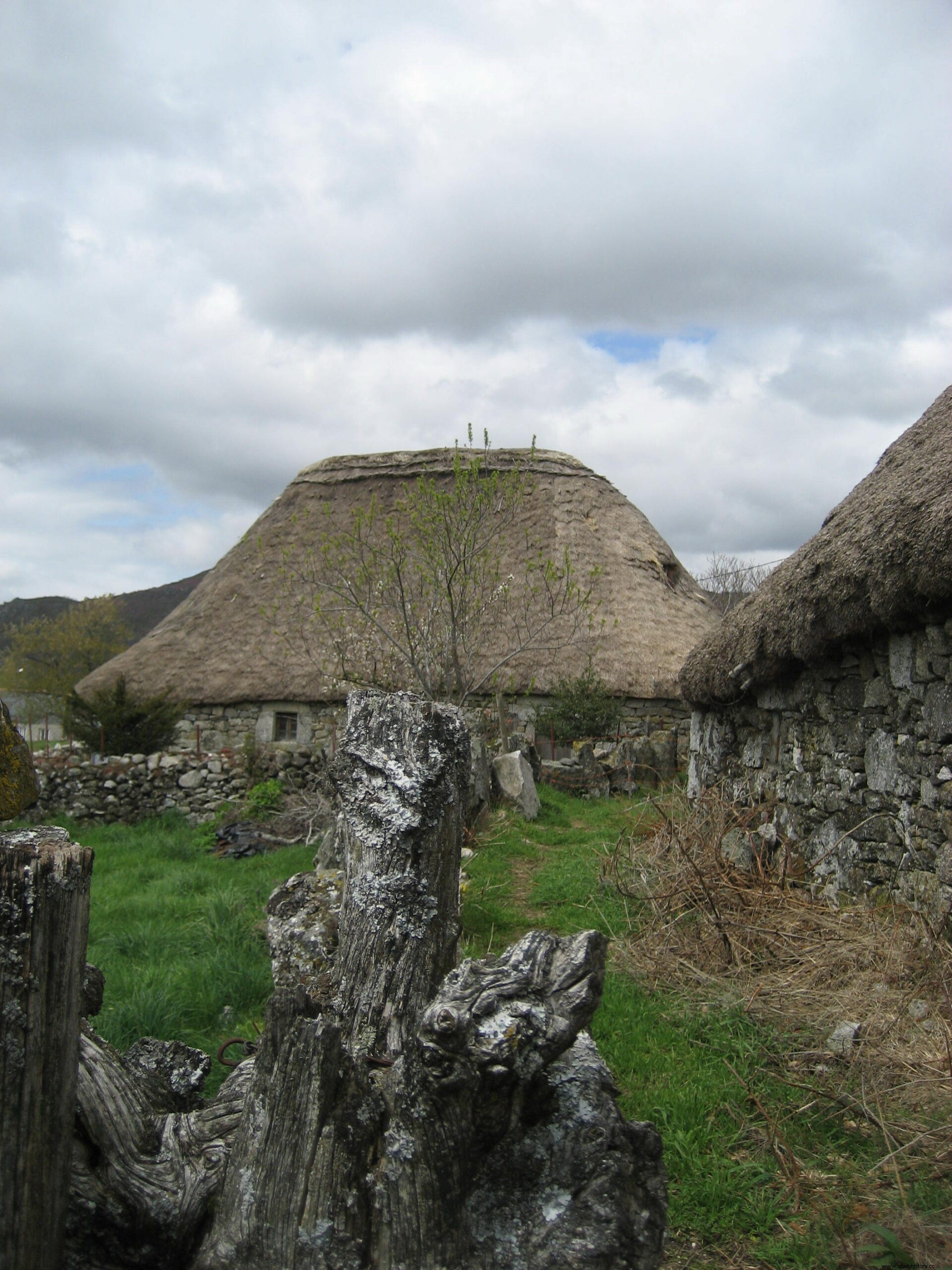
Ancient ruins of the original Celtic inhabitants of the Gallaecia region
Germanic tribes
As that era wore on, Germanic tribes known as Suebi arrived from Central Europe and settled in the area where they established the kingdom of Gallaecia from 406–586 AD, respectively. They were one of the first post-Roman kingdoms to become independent from the Roman Empire on the Iberian Peninsula. During this age, many migrations took place in the territory. For example, with Britons from Britain arriving in Gallaecia as a refuge since being driven out by new Anglo-Saxon invaders who arrived on their shores.
Furthermore, there were other Germanic groups who settled in the area that became known as the Vandals. They originally spoke a Germanic language that is remarkable as modern Upper and High German. As a result of these ethnic groups settling in Gallaecia, it now remains one of the highest parts of Portugal to have Germanic genes and the physical characteristics of blonde, red and fairer traits on the Iberian Peninsula. With a whole new mix of people coming together in this region, they had created the capital of the city of Braga (Guimaraes). Only to be later annexed to Visigothic Hispania and face possible separation from Spanish kingdoms when the new land became prominent along with the Reconquista events that later occurred.

Visual representation of Germanic tribes that settled in the Gallecia region throughout history
Linguistics
The kingdom of Gallaecia covered the regions of present-day northern Portugal, Galicia, Asturias and western Castilla y Leon in Spain. To add, the language spoken in this kingdom was known as Galician-Portuguese. It has been identified as the predecessor of modern Portuguese and Galician, as they are now considered dialects of the same idiom, which is still interestingly understandable after over seven centuries of political separation.
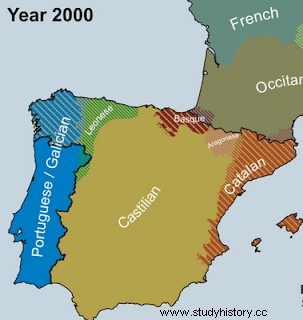
Map of the Iberian Peninsula illustrating how closely related and understandable the languages of Galician and Portuguese are when they share borders.
Foundation
The country's first king, Afonso Henriques, called this city his home as his birthplace. This served as another key factor in the basis of the country's rise and general past. In 1128, major political and military events that would lead to the birth of a new nation took place in Guimarães. From then on, Portugal began to expand its territories south of the country when it began to recapture territory taken by the Moors. For this reason, on one of the old towers in the city's old wall is written "Aqui nasceu Portugal", which means (Portugal was born here). (Wikipedia). For its part, the city of Guimarães began its creation through a very strenuous process that provided inspiration and drive.
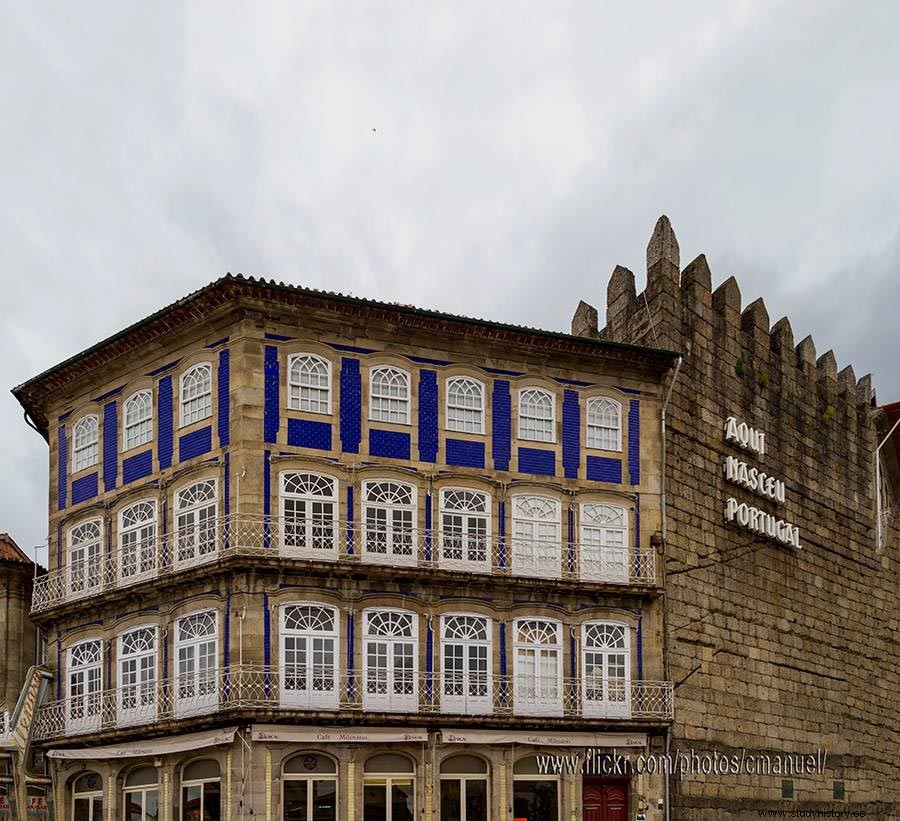
Famous wall in the city of Guimaraes with inscriptions highlighting the city's existence as the birthplace of Portugal
architecture
In addition to the diverse foundation in Portugal. The majority of the architecture on the streets reflects back to its medieval character. Since the styles are mainly Gothic. To add, the most popular and captivating squares found in this city are called Largo de Oliveira and Praca de Santiago. Although partially separated by the former council chamber building, Largo de Oliveira. It includes the Church of Our Lady of the Olive Tree, the Gothic arches of the Salado Monument and the Alberto Sampaio Museum. Another area where one can discover different architectural styles can be located at Largo do Toural. Which at the time had been formally used as a pet market outside the city walls that perfectly shows the city's historic shifts.
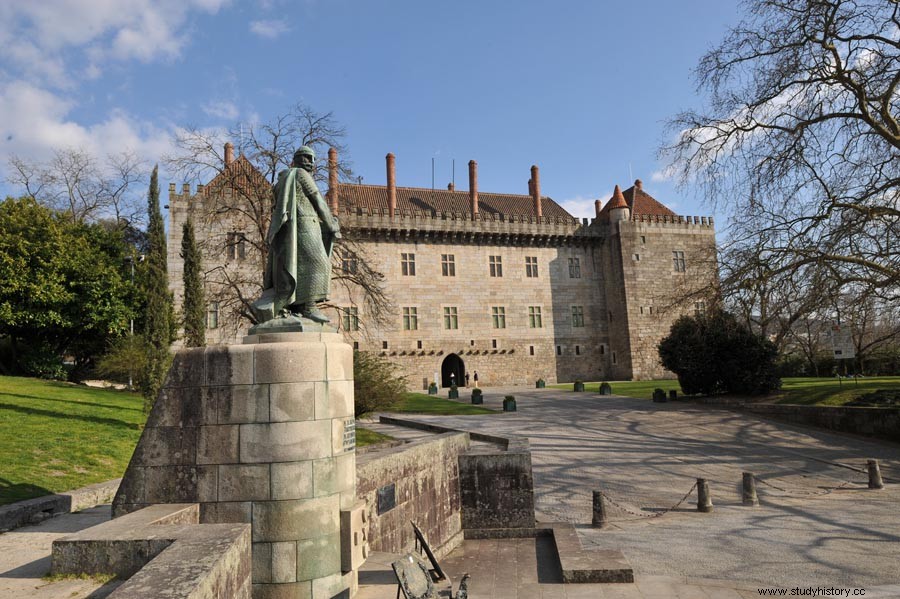
The image of Guimarae's castle together with the statue of the first king, Afonso Henriques immortalized forever in its best glory.
Ducal Palace and Castle of Guimarães
The Ducal Palace also serves as an interesting sight to visit since it was created by Portugal's highest ranked nobleman after the monarchy had been abolished. The Duke of Braganca had the palace built in 1420. It shows a large and thick set of red chimneys. Which made it an impressive architectural marvel throughout its history. In addition, it boasts furniture with strikingly carved antique pieces, detailed tapestries, painted ceilings and stained glass windows, as well as exhibitions of more contemporary art, including works by the local artist José de Guimarães.
Finally, the most famous attraction in this city would be the Castle of Guimarães (O Castelo do Guimarães). The purpose of existing in the tenth century served as a defense against Norwegians who arrived from the north and Moors from the south. It is also better known for its bronze statue of Portugal's first king, Afonso Henrique, who greets visitors at the entrance. In all, Guimarães has a number of historical architectural treasures to offer.

Caldo Verde:a cultural stamp for Portuguese cuisine
Food culture
Then Guimarães consists of some original and historical traditions / delicacies that are still very much present in Portuguese culture. Caldo Verde (green soup) originates, for example, from the province of Minho, where the dish became a well-known recipe in the country. The main course can also be found in other parts of the globe. Where Portuguese societies settled all over the world, such as America, Asia and beyond. The soup can usually be eaten at celebrations such as weddings, birthdays and the Festa de São João do Porto (Saint John Festival of Porto).
Food in northern Portugal, specifically Guimarães, is usually based on farm products that contain strong and rich flavors. Some other products made by the inhabitants of the region are Cabrito Assado (fried lamb), Arroz "Pica no Chão" (rice made with chicken), Rojões (slow-cooked pork) and the famous Bacalhau Assado (fried salted cod). Not only is there good organic food there, but Guimaraes also offers traditional Vinho Verde (green wine). In addition to other light and exceptionally rich flavors .. They are freshly handled in the vineyards by farmers in the city. For its part, the inhabitants of Guimarães continue to preserve their ancient culinary customs and ways throughout their history, while setting a good example by being the foundation of the country.
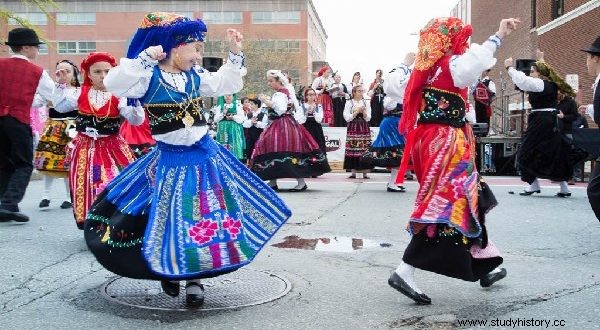
Fun example of a traditional northern Portuguese folk dance that celebrates its Celtic roots.
Culture and tradition throughout history
On the other hand, Guimarães also offers an impression of his Celtic roots through music and dance. With instruments such as gaits (bagpipes) and dancers such as Vira and Chula. followed by Corridinho, Malhao and Fandango. They are all reminiscent of Scottish, Irish, Welsh, Cornish and Breton folk dances. Traditional dress also still reminds of the shared story with the now Galician brothers. As both cultures mirror-mirror each other unconsciously. That said, there are many deep-rooted traditions. Where this region still hails and mimics its origins beautifully.
Furthermore, a universal symbol of the country in Guimarães also originates in the province. It became known as Galo de Barcelos (The Rooster of Barcelos). It consists of an entertaining background story. Regarding a dead rooster in the seventeenth century who miraculously intervenes to prove a man's innocence. Who was falsely accused of and sentenced to death. Since the story was distributed, it has therefore become a national image for the country. As is common to find many wooden faucet copies sold as souvenirs throughout Portugal. Nearby, Guimaraes has a number of fun and memorable customs that many will enjoy when they experience it.
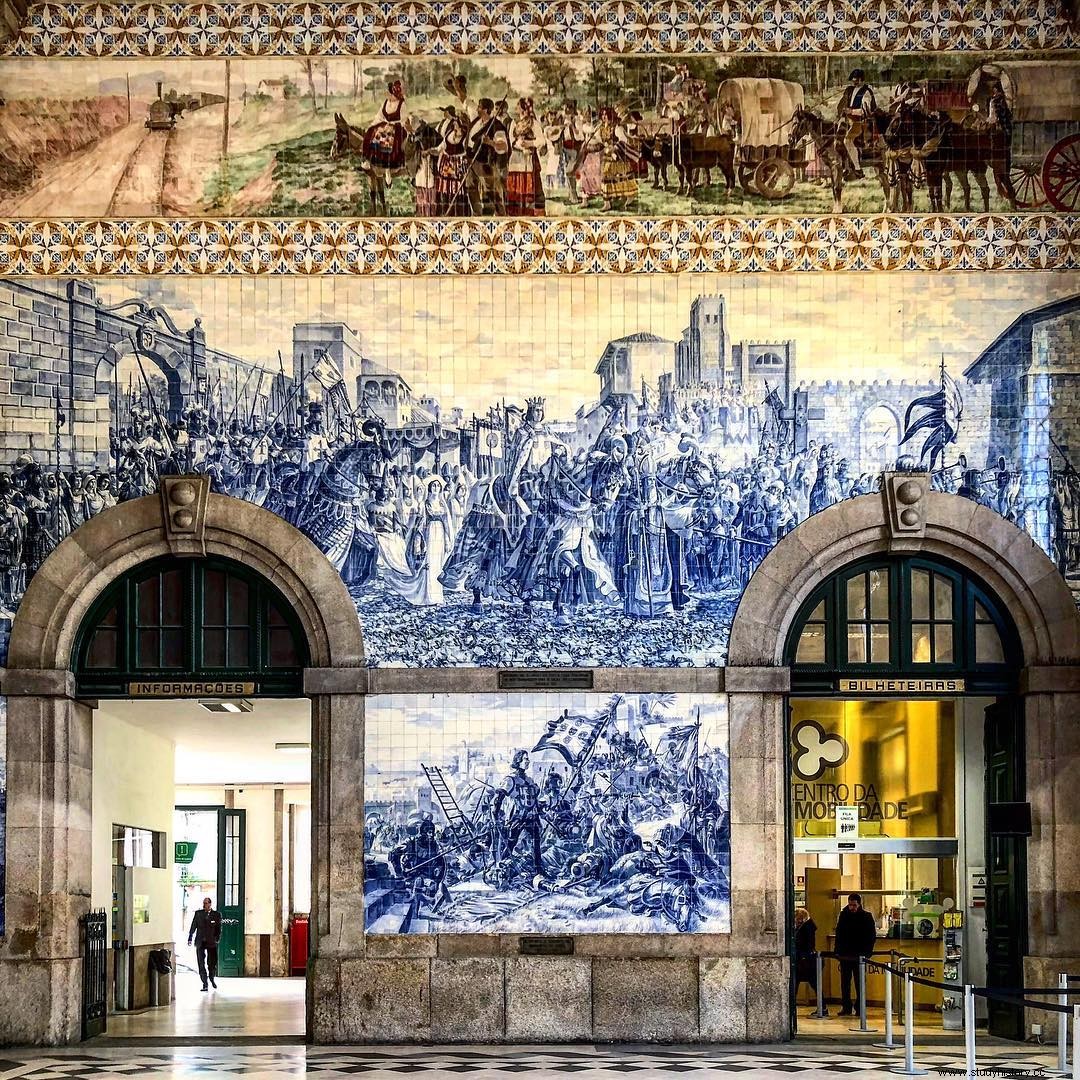
Beautiful view of an Azulejo in northern Portugal depicting the country's rich history
Art History
Furthermore, Guimarães is a highly recommended destination for anyone wondering about a stimulating environment. Since it has to offer a bit of everything for everyone. With rich history, culture and geographical location to offer. Many will not be disappointed with the discovery of the city. To illustrate, there is a lot of visual art present throughout the square. With art museums averaging at least one per city to three or more in major cities across the country. In addition, street art was easily discovered in the squares. Which later became known as "Azulejos". They are ceramic tiles that often show historical events from the country's long maritime history.
Literature from the region also inspired great works and authors. Such as "De Camoes as Portugal's" and "Os Lusiadas" by Luis Vaz de Camoes. These are poems that tell the story of the famous explorer Vasco de Gama's famous voyage to find India. Other pieces include stories reminiscent of Greek epics such as Homer's Odyssey and "The Lliad". In northern Portugal, the oldest bookstore can also be located there. With its earlier dates dating back to 1732.

The dark and mysterious Bicho Papao is waiting to find his new victim.
Former religion and mythology
With the founding of Portugal's Christian kings, the Roman Catholic faith remains the most dominant. One occurrence is detected. In stories through a well-known and famous story related to the church in Portuguese mythology. When the spirit of Mary appeared to three shepherd children and delivered a message of peace. Therefore, with stories like these in hand, more superstitions and mythical creation legends began to emerge. Such as "The Bicho-Papão", which is a supernatural being that nourishes people's fears, but especially young children like more. It most likely served as an inspiration to author JK Rowling. Since she implemented this mythical creature in her infamous literary work in the series "Harry Potter".
The creature is a transformer that becomes one's worst nightmare. In addition, no one really knows what it really looks like. The cryptic period may lie throughout the former region of what was Gaellaecia in the Iberian Peninsula. It was mobilized today as a figure and a tool for parents to scare their naughty children when they behave badly in Portugal.
Moura Encatada
Then "Moura Encatada" evolved into existence. By being met all over the country. She can be in the woods and comb her long hair where she greets the person who meets her. To then ask them to break her curse in exchange for not gathering their soul.
Although the curse is challenging to overcome. A person can achieve a wish when they conquer the test. She may guard castles and rivers. People applaud her with positivity as a symbol of happiness. Instead of threatening. As a result, the city of Guimarães was responsible for many of these iconic folklore and established practices. Followed by historical figures that everyone can recognize when they travel to Portugal.

Guimarães in its Gothic glory on a gloomy afternoon.
Important factors that shape a nation
Finally, the city of Guimarães has had its share of ups and downs that it pushed through. Then it became the catalyst and origin of the country Portugal that we all know and love today. Despite the ancient Celtic languages that were once spoken in the area and were lost over time. Unfortunately, the country is overlooked by others for its true origins from its cousins across the Atlantic.
The Celtic spirit still lives on through tradition. History will always be here to educate and remind many of the relationship and history of the beginning. Although each region of the country eventually carried out its own individual traditions and identities. New dialects and ideas soon developed. All in all, Guimarães will always remain an example to follow and reflect on. Since it will always provide a warm and enlightening experience for those seeking adventure.
Works Cited
Home - Europe is not dead!
Guimarães - Wikipedia
Suebi Kingdom - Infogalactic:the planet's core of knowledge
Devotion &Religious Festivals in Northern Portugal (visitportoandnorth.travel)
The Celtic People - A Complete History of the Celts (englishmonarchs.co.uk)
Guimarães:A Medieval City in Northern Portugal (beportugal.com)
Traditional Portuguese cuisine in Guimarães and Braga | Best bits in the world
Similar blogs related to travel and history in Portugal:
Óbidos, Portugal:The ideal city for libraries
Travel Guide:Discover the charming Romania and its mysterious natural atmosphere
Anthropology:The Global Impact of Arab Inventions and Culture
Anthropology in fashion:cultural clothing in East Asia
